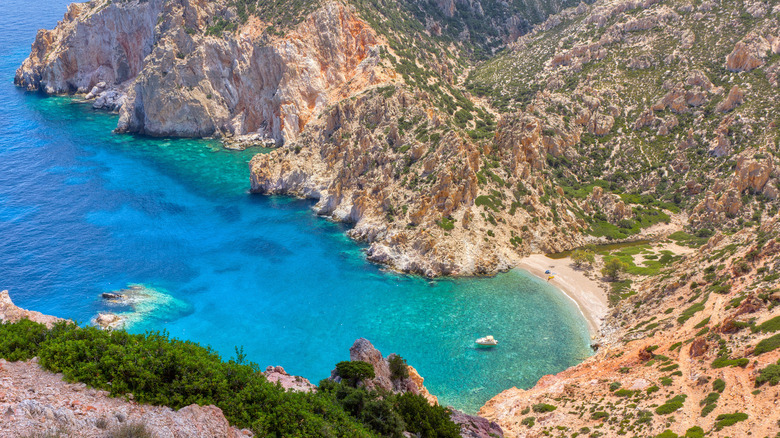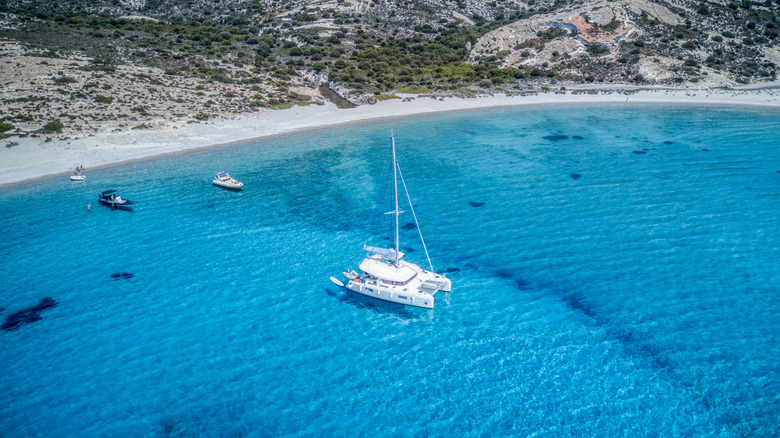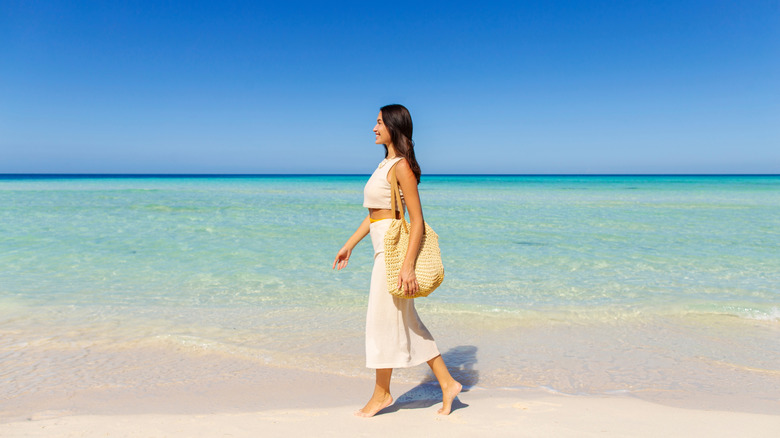This Lesser-Known European Island Is A Tropical Paradise Of Uninhabited Beauty
If your idea of paradise features turquoise waters and sun-bleached cliffs, then your go-to Greek island should be Polyaigos (also written as Polyegos), an underrated tropical vacation destination for your bucket list. A raw beauty nestled in the Aegean Sea and part of the Cyclades, this uninhabited volcanic island — next to the more popular Milos — is a rare and pristine destination. Travelers wanting to literally step into solitude and nature itself, can enjoy the surrounding sounds coming only from waves, sea breeze, and goats. Yes, you read that right: goats. These goats, which have been grazing on the island for years, are the only known inhabitants. This explains the name Polyaigos, which translates to "many goats" in Greek.
With no infrastructure in sight, Polyaigos has been left to evolve naturally over the years. It's part of the European Union's Natura 2000 network of protected environments due to its unspoiled natural qualities. Moreover, the island's uniqueness is further pronounced by its towering limestone formations, hidden sea caves, and its crystal-clear water that's so surreal it looks digitally enhanced. Whether you're watching goats wandering the cliffs, or listening to waves echoing in empty sea caves, your dream of a true escape without distractions is sure to be realized with a visit to Polyaigos.
Top things to see and do in Polyaigos
Blue Bay (also known as Chochlakia) is one of the most jaw-dropping attractions on Polyaigos, with its surrounding sea glowing with iridescent grace against white marble-like cliffs. Imagine swimming in liquid sapphire: immersing yourself in this bay can give you that magical feeling. Boat tours leaving from Milos usually anchor here to swim and have lunch, providing a chance to snorkel through the calm water or sunbathe on the volcanic shores. The unique formation of the cove also makes it a popular spot for drone pilots.
The Polyaigos Lighthouse is another must-see attraction on the island's southeastern cliffs, offering a breathtaking panoramic view of the surrounding Cyclades. Even though the lighthouse is no longer functional, it's definitely still a worthy landmark filled with sweeping vistas over the Aegean Sea. Getting there requires a 30-minute, scenically rewarding hike from the coast; make sure you bring sturdy shoes and enough water. You might also aim for golden hour if your tour allows.
You sure wouldn't want to miss Fanara Cave, which is known for its gaping roof through which sunlight streams in like a spotlight shimmering upon the aquamarine water. For wildlife spotting, keep an eye out for Mediterranean monk seals, one of the world's most endangered marine mammals, as they've found a haven in these caves. If you're interested in birdwatching, rare species like Eleonora's falcons and Bonelli's eagle can also be found around.
Where to stay in Polyaigos and how to get there
Milos is a common starting point for journeys to Polyaigos, and accessible via the Milos National Airport (MLO) or by ferry from a neighboring island or even Athens. Once you're on the island, head to the port in Adamas to join a half- or full-day cruise to Polyaigos, which typically costs around $50 to $100 per person. Tours also leave from the village of Pollonia in the northeastern part of Milos.
With no roads, hotels, or any other developments, when you visit Polyaigos, you need to stay on the neighboring islands of Milos or Kimolos. In Milos, Pollonia and Adamas are popular bases where you can find a variety of hotels, guesthouses, and boutique stays for about $80 to $180 per night in the high season from June through August. For something quieter, lodgings in Kimolos may be a good fit too; a ferry ride from Milos will get you there in less than an hour. It's highly advisable to book accommodation in advance during the summer months.
Don't forget to pack your Greek hotspot travel essentials such as reef-safe sunscreen, snorkeling gear, a reusable water bottle, swimwear, and snacks. Most of the beaches have no shades, so it's helpful to bring along a light sarong or UV shirt. The best time to visit this hidden gem? That's April through June or September through October for a less crowded affair, pleasant weather conditions, and lower prices. Still, if you prefer a more lively atmosphere and don't mind the heat and the crowds, July and August would give you just that. But be wary of occasionally strong seasonal winds known as "meltemia," which tend to affect the Cyclades in August. For another adventure in the Cyclades, head to Folegandros, a Greek Island with scenery like Santorini but lower prices.


